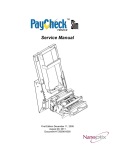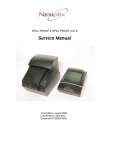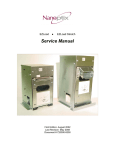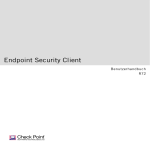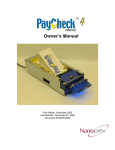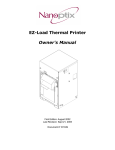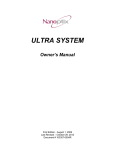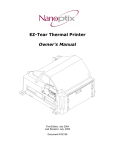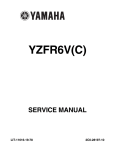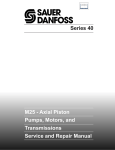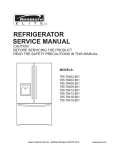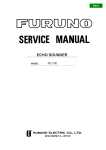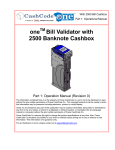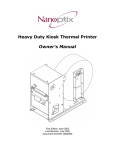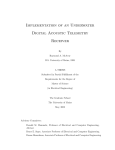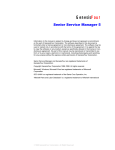Download Technicians Manual - Support
Transcript
PayCheck™ ● PayCheck 2™ ● PayCheck 3™ ● PayCheck 4™ Technicians Manual First Edition August 1, 2006 Revision March 6, 2013 Document # 720004-0000 Technicians Manual Legal Notices Disclaimer Information in this document is subject to change without notice. Consult your Nanoptix Inc. sales representative for information that is applicable and current. Nanoptix Inc. reserves the right to improve products as new technology, components, software and firmware become available. No part of this document may be reproduced or transmitted in any form or by any means, electronic or mechanical, for any purpose without the express written permission of Nanoptix Inc. Copyright Copyright 2003 by Nanoptix Inc. Dieppe, New Brunswick Canada All rights reserved Printed in Canada Confidential, Unpublished Property of Nanoptix Inc. Trademarks Epson is registered trademark of Epson Corporation. Windows is registered trademark of Microsoft Corporation. Nanoptix is a trademark. Other trademarks and registered trademarks are the property of their respective holders. Federal Communications Commission (FCC) Radio Frequency Interference Statement Warning Changes or modifications to this unit not expressly approved by the party responsible for compliance could void the user’s authority to operate the equipment. Note This equipment has been tested and found to comply with the limits for a Class B digital device, pursuant to Part 15 of the FCC Rules. These limits are designed to provide reasonable protection against harmful interference when the equipment is operated in a commercial environment. This equipment generates, uses, and can radiate radio frequency energy and, if not installed and used in accordance with the instruction manual, may cause harmful interference to radio communications. Operation of this equipment in a residential area is likely to cause harmful interference in which case the user will be required to correct the interference at his own expense. Document # 720004-0000 March 6, 2013 ii Technicians Manual Information to the User This equipment must be installed and used in strict accordance with the manufacturer's instructions. However, there is no guarantee that interference to radio communications will not occur in a particular commercial installation. If this equipment does cause interference, which can be determined by turning the equipment off and on, the user is encouraged to contact Nanoptix Inc. immediately. Nanoptix Inc. is not responsible for any radio or television interference caused by unauthorized modification of this equipment or the substitution or attachment of connecting cables and equipment other than those specified by Nanoptix Inc. The correction of interferences caused by such unauthorized modification, substitution or attachment will be the responsibility of the user. In order to ensure compliance with the Product Safety, FCC and CE marking requirements, you must use the power supply, power cord, and interface cable, which were shipped with this product or which meet the following parameters: Power Supply UL Listed power supply with standard 60Hz-50Hz, 100-240VAC input and 24VDC output equipped with AC line filtering, over-current and short-circuit protection. Use of this product with a power supply other than the Nanoptix Inc. power supply will require you to test the power supply and Nanoptix Inc. printer for FCC and CE mark certification. Communication Interface Cable An approved Nanoptix interface cable must be used with this product. Use of a cable other than Nanoptix approved product will require that you test the cable with the Nanoptix Inc. printer and your system for FCC and CE mark certification. Power Cord A UL listed, detachable power cord must be used. A power cord with Type SVT marking must be used. For applications outside the North America, power cords that meet the particular country’s certification and application requirements should be used. Use of a power cord other than described here may result in a violation of safety certifications that is in force in the country of use. Industry Canada (IC) Radio Frequency Interference Statement This Class B digital apparatus meets all requirements of the Canadian Interference-Causing Equipment Regulations. Cet appareil numérique de la classe B respecte toutes les exigences du Règlement sur le matériel brouilleur du Canada. Document # 720004-0000 March 6, 2013 iii Technicians Manual Table of Contents About the Printer............................................................................................................ 1 1.1 Description of Printer .................................................................................................. 1 1.2 General specifications .................................................................................................. 2 1.3 Paper Loading .............................................................................................................. 3 1.4 Printer Interface Ports................................................................................................. 5 1.5 Printer Controls ........................................................................................................... 6 Printer Reset (Service use only) ........................................................................................... 6 Paper Feed Button ................................................................................................................ 6 Firmware Selector DIP switches ......................................................................................... 7 Boot mode Selector DIP switches ........................................................................................ 8 Watch Dog jumper ............................................................................................................... 9 Bezel illumination control jumper....................................................................................... 9 LED ...................................................................................................................................... 10 1.5.1 1.5.2 1.5.3 1.5.4 1.5.5 1.5.6 1.5.7 1.6 Testing the Printer ..................................................................................................... 11 1.7 Clearing Jams ............................................................................................................. 12 2 Troubleshooting the Printer .................................................................................... 13 2.1 Basic Printer Operation............................................................................................. 13 2.2 Communication Cables Pin-Out ............................................................................... 14 Universal Communication interface ................................................................................. 14 Serial Interface Connection pin-out .................................................................................. 15 Illuminated bezel interface................................................................................................. 15 2.2.1 2.2.2 2.2.3 2.3 2.3.1 Printing Problems ...................................................................................................... 16 Main Controller PCB Connector Layout ......................................................................... 17 3 Media and Supplies Guide ....................................................................................... 18 3.1 Thermal Paper Specifications ................................................................................... 18 3.2 Ordering Thermal Paper........................................................................................... 20 3.3 Ordering Communication Cables............................................................................. 20 3.4 Parts List ..................................................................................................................... 21 4 Mechanical Drawings .............................................................................................. 23 5 Spare parts replacement instructions ...................................................................... 25 6 Printer Maintenance Instructions ........................................................................... 36 7 Service & Support .................................................................................................... 40 7.1 Returning printers back to Nanoptix for repairs (RMA) ....................................... 40 7.2 Technical Support Contact Information.................................................................. 40 Document # 720004-0000 March 6, 2013 iv Technicians Manual Figures FIGURE 1: NANOPTIX PAYCHECK™ PRINTER .............................................. 1 FIGURE 2: TICKET STACK ORIENTATION ...................................................... 3 FIGURE 3: LOADING PAPER ........................................................................ 4 FIGURE 4: INTERFACE PORTS ..................................................................... 5 FIGURE 5: PRINTER RESET ......................................................................... 6 FIGURE 6: PAPER FEED BUTTON ................................................................. 6 FIGURE 7: F/W DIP SWITCH ....................................................................... 7 FIGURE 8: BOOT SELECTOR........................................................................ 8 FIGURE 9: WATCH DOG (PAYCHECK 3™ & PAYCHECK 4™ ONLY) .............. 9 FIGURE 9: BEZEL CONTROL ........................................................................ 9 FIGURE 9: LED POSITIONS ....................................................................... 10 FIGURE 10: SAMPLE TEST TICKET............................................................. 11 FIGURE 11: CLEARING JAMS – PAYCHECK™ 1, 2 & 3 ............................... 12 FIGURE 12: CLEARING JAMS – PAYCHECK 4™ ......................................... 12 FIGURE 13: SENSORS ............................................................................... 13 FIGURE 14: CONNECTOR LAYOUT (PAYCHECK™ SHOWN) ......................... 17 FIGURE 15: PERFORATION TEST ............................................................... 18 FIGURE 16: TICKET SPECIFICATIONS ......................................................... 19 FIGURE 17: MECHANICAL DIMENSIONS ...................................................... 24 FIGURE 18: MAIN BRACKET ...................................................................... 25 FIGURE 19: TICKET TRAY ......................................................................... 25 FIGURE 20: BASE PLATE .......................................................................... 26 FIGURE 21: FLAT CABLE A ....................................................................... 26 FIGURE 22: FLAT CABLE B ....................................................................... 27 FIGURE 23: DAUGHTER PCB .................................................................... 28 FIGURE 24: PRINTING MECHANISM – PAYCHECK™ 1, 2 & 3....................... 29 FIGURE 25: PRINTING MECHANISM PAYCHECK 4™ ................................... 30 FIGURE 26: MAIN PCB ............................................................................. 31 FIGURE 27: PAPER GUIDE......................................................................... 32 FIGURE 28: PAPER GUIDE SENSOR – PAYCHECK™ 1, 2 & 3...................... 33 FIGURE 29: PAPER GUIDE SENSOR – PAYCHECK 4™ ................................ 33 FIGURE 30: MECH KIT – PAYCHECK 4™ ................................................... 34 FIGURE 31: DISASSEMBLY ........................................................................ 35 FIGURE 32: REMOVE TICKET TRAY ............................................................ 36 FIGURE 33: REMOVE EXCESS DUST ........................................................... 36 FIGURE 34: REMOVE TOP PAPER GUIDE ..................................................... 37 FIGURE 35: REMOVE ROLLER ................................................................... 37 FIGURE 36: CLEAN ROLLER ...................................................................... 37 FIGURE 37: CLEAN PAPER GUIDE SENSOR USING COTTON SWAB................. 38 FIGURE 38: BOTTOM PAPER GUIDE INSPECTION ......................................... 38 FIGURE 39: CLEAR DUST OFF GEARS USING LIGHT BRUSH .......................... 39 FIGURE 40: CLEAN PRINT LINE ................................................................. 39 Document # 720004-0000 March 6, 2013 v Technicians Manual Tables TABLE 1: SPECIFICATIONS .......................................................................... 2 TABLE 2: INTERFACE PORTS ....................................................................... 5 TABLE 4: BOOT SELECTOR ......................................................................... 8 TABLE 4: WATCH DOG JUMPER................................................................... 9 TABLE 4: BEZEL CONTROL ......................................................................... 9 TABLE 5: LED INFORMATION .................................................................... 10 TABLE 6: 14 PIN RS232 SERIAL INTERFACE ............................................. 14 TABLE 7: RS-232 SERIAL INTERFACE PIN-OUT ......................................... 15 TABLE 8: BEZEL INTERFACE ..................................................................... 15 TABLE 9: TROUBLESHOOTING PRINTING PROBLEMS .................................. 16 TABLE 10: CONNECTOR FUNCTIONS ......................................................... 17 TABLE 11: PAPER SPECIFICATIONS ........................................................... 18 TABLE 12: ORDERING THERMAL PAPER .................................................... 20 Document # 720004-0000 March 6, 2013 vi Technicians Manual About the Printer 1.1 Description of Printer The Nanoptix PayCheck™ printer, is extremely fast, quiet, and very reliable. With thermal printing technology, there is no ribbon cassette to change, and paper loading is extremely simple. The printer is small enough to fit almost anywhere and is easy to use with the ticket exiting from the front. Figure 1: Nanoptix PayCheck™ Printer Document # 720004-0000 March 6, 2013 1 Technicians Manual 1.2 General specifications Print Method Resolution Print Width Paper Width Cartridge Size Operating Temperature Storage Temperature Operating Relative Humidity Communication Interface Options Memory/Firmware Resident Character Sets Integrated Bar Codes Speed Sensors Duty Cycle (max.) Human Interface Dimensions Weight Immunity Emission Standards Safety Direct Thermal 8 dot/mm (203 dpi) 64mm 65mm 200, 400, 600, 800 0° to 50° C -40° C to 65° C 5% to 90% RH at 50C (non-condensing) Bidirectional RS-232C Dedicated USB Comm Dedicated USB Maintenance Port PayCheck™ & PayCheck 2™: 1 Mbit of RAM, 2 Mbit flash & 16Kbit EEPROM PayCheck 3™ & PayCheck 4™: 2 Mbit Flash, 1 Mbit Ram & 16 kbit EEPROM Support 32 fonts Approx. (16 resident 16 user defined) UPC-A, UPC-E, interleaved 2 of 5, Code 39, Code 93, Codabar, EAN 8, EAN 13, Code 128. Note: Other Bar Codes can be programmed quickly PayCheck™ & PayCheck 2™: Up to 125 mm/sec. (monochrome) PayCheck 3™ & PayCheck 4™: Up to 200 mm (8 in.) per sec. (monochrome) Up to 125 mm (5 in.) per sec. (two-color mode) Paper low, paper out, ticket taken, drawer open, ticket jam, ticket in chute, black mark 5 tickets per minute Drop-in paper loading, status LEDs, paper feed button 113mm width x 67mm height x 286mm depth 2.3 Kg EN 55024 Information Technology Equipment United States - FCC Part 15 Subpart A Canada - Industry Canada ICES-003 Europe – EN 55022 Class B emissions Information Technology Equipment QPS Certified Control Number: LRE1123 Table 1: Specifications Document # 720004-0000 March 6, 2013 2 Technicians Manual 1.3 Paper Loading The paper stack should be changed when it is low or out. Caution: The printer will not operate without paper, but it may continue to accept data from the host computer. Since the printer cannot print any transactions, the data may be lost. The maximum stack that will fit in the ticket cartridge is 200, 400, 600 or 800 tickets depending on the cartridge option that was purchased with the printer. Ticket stack orientation: The stack must be oriented so that it’s top of form mark is on the leading edge of the ticket. Figure 2: Ticket Stack Orientation Document # 720004-0000 March 6, 2013 3 Technicians Manual A Open drawer. (if necessary) C Feed ticket into printer mechanism until resistance is felt. B Drop ticket stack into ticket cartridge. D Once paper has been aligned ticket is ready to print. Figure 3: Loading Paper Document # 720004-0000 March 6, 2013 4 Technicians Manual 1.4 Printer Interface Ports Port Identification A B C D Connector Type 14 pin “Molex type” USB type B USB type B 3 pin “Molex type” Function RS-232 Communication USB Communication USB Maintenance Bezel LED Table 2: Interface Ports (B) USB type B (A) 14 pin “Molex” type (D) 3 pin “Molex” type (C) USB type B Figure 4: Interface Ports Document # 720004-0000 March 6, 2013 5 Technicians Manual 1.5 Printer Controls 1.5.1 Printer Reset (Service use only) The printer is reset by disconnecting and reconnecting the power/communication cable. Once connected, the printer goes through a startup routine and resets itself. Figure 5: Printer Reset 1.5.2 Paper Feed Button The paper feed button is used to advance the paper. Once the ticket removed, the printer will realign the paper to the ready position. Paper Feed Figure 6: Paper Feed Button Document # 720004-0000 March 6, 2013 6 Technicians Manual 1.5.3 Firmware Selector DIP switches PayCheck 3™: Remove the ticket tray to access the firmware selector DIP switches. PayCheck 4™: DIP switch is available through access hole in paper tray. Various firmware and setting configurations are available by selecting the 16 different DIP switch combinations. (Applies to PayCheck 3™ & PayCheck 4™ only) Figure 7: F/W DIP Switch DIP switch functions vary in different firmware versions Document # 720004-0000 March 6, 2013 7 Technicians Manual 1.5.4 Boot mode Selector DIP switches PayCheck 3™: Remove ticket tray and plate to access the boot mode selector DIP switches. PayCheck 4™: Remove ticket tray plate to access the boot mode selector DIP switches. Different boot options are available by selecting the 4 different DIP switch combinations. Figure 8: Boot Selector DIP switch settings Function OFF-OFF Run mode (default setting) OFF-ON None ON-OFF None ON-ON Recovery mode (Corrupted firmware) Table 3: Boot Selector Document # 720004-0000 March 6, 2013 8 Technicians Manual 1.5.5 Watch Dog jumper Figure 9: Watch Dog (PayCheck 3™ & PayCheck 4™ only) Jumper setting Function ON Run mode (default setting) OFF Recovery mode (disable watch dog) Table 4: Watch Dog jumper 1.5.6 Bezel illumination control jumper Figure 10: Bezel Control Jumper setting ON OFF Function Bezel illumination control connected to pin 9 of host I/O Bezel illumination control not available on Pin 9 of host I/O Table 5: Bezel Control Document # 720004-0000 March 6, 2013 9 Technicians Manual 1.5.7 LED Note: An external LED bezel can be connected through the front 3-pin “Molex” type connector. (Pin-out is described in section 2.2.3) Error LED (Red) OFF ON MED BLINK Status LED (Green) ON OFF OFF OFF OFF OFF SLOW BLINK OFF ON (Bright) FAST BLINK FAST BLINK FAST BLINK ON ON ON OFF OFF OFF Voltage LED (Red) (PayCheck 2™ only) Condition Printer Ready Paper Out Temperature Error Voltage Error (Over 26.2 VDC) Print Head Error Missing Black Index Mark Paper Jam Table 6: LED Information Error LED (RED) Status LED Voltage LED (GREEN) (RED – PayCheck 2™ only) Figure 11: LED Positions Document # 720004-0000 March 6, 2013 10 Technicians Manual 1.6 Testing the Printer This test can be used to verify the correct operation of the printer. The test prints a resident ticket listing the current printer settings. This ticket can also be used to verify the printing quality. PayCheck™ & PayCheck 2™: To print the test ticket, the printer must be powered “ON” while holding the paper feed button for approximately 5 seconds. Once repetitive beeping is heard, release the paper feed button. A test ticket similar to the one below will be printed. Pressing the button again will result in blank tickets. PayCheck 3™ & PayCheck 4™: To print the test ticket, the printer must be powered “ON” while holding the paper feed button for approximately 5 seconds. A status ticket similar to below will be printed. Pressing the button again will result in blank tickets. Model: Firmware: User Version: Protocol: COMMUNICATION Interface: Baud Rate: Handshaking: Print mode: Back USB : PRINT CONTROL Speed: Black Bar Index: No HPQ Burn Time: Motor Current: Real-Time Command: Auto Reset Status: Validation Bit: Save Valid Bit: PRINTER ENVIRONMENT CONDITIONS Voltage: Temperature: SYSTEM RESOURCES FLASH Used=00000 RAM: Used=00000 Free=65535 Free=65535 LIBRARY INVENTORY (CUSTOM) Templates: 6 Regions: Fonts : Graphics: MANUFACTURING INFORMATION Printer ID: Date Code: A to D: 03d8, 021a, 0231, 03c6 Dip Switch Config (1234): 0000 Status: *S|0|PAY-4.82H|@|@|@|I|@|P|* PAYCHECK 4 PAY-4.82H (0x1CB1) S R.2.4.0 NTL Serial 38400,8,NONE PRT+RTS NTL Fw Controlled 100 mm/sec Right 250 us 2 Enabled Disabled Smart TOF Enabled 24.7 Volts 25 Celcius 1,2,3,4,5,6,7,8,h,9,A,B,C,D ,E,F,G,I,J,K,L,N,O,P,Q,R, S,T,U,Z,X,a,b,c,d,e,f,g,i,j,k, l,m,n,o,p,q,s,t,u,v,w 0,1,2,3,4,5,6,7,8,9,A,B P312681 20100215 Figure 12: Sample Test Ticket Document # 720004-0000 March 6, 2013 11 Technicians Manual 1.7 Clearing Jams The Nanoptix PayCheck™ printer’s paper guide and printing mechanism roller are easily removed, giving full access to the paper path. Figure 13: Clearing Jams – PayCheck™ 1, 2 & 3 Figure 14: Clearing Jams – PayCheck 4™ Document # 720004-0000 March 6, 2013 12 Technicians Manual 2 Troubleshooting the Printer 2.1 Basic Printer Operation Although the Nanoptix PayCheck™ printer is a complex device, its operation is quite simple. The printer requires two consumables to operate, (1) a regulated 24 VDC power source and (2) thermal paper. The printer is equipped with three communication interface ports: one power/communication port situated at the bottom rear of the unit, one USB port at the top rear of the unit and one maintenance USB port situated on the side of the printer. A 3-pin I/O connector situated at the front of the unit can be used to control an external illuminated bezel. The two main components of the printer, the base assembly and the main bracket are connected together via a white flat cable. A photo-interruptible sensor is used to detect the main bracket’s open/close status. A reflective optical sensor situated at the front of the ticket tray is used to detect a low paper condition. A third optical sensor is used in the printing mechanism assembly to detect the presence of paper and start the feeder motor when loading paper. This sensor also works in conjunction with a fourth optical sensor situated in the paper chute to realign paper back to its “ready” position. When the sensors are not reporting any errors and a recognized data stream is sent to the printer, a printed ticket will result. Paper in Chute Paper Low Top of Form Tray In Figure 15: Sensors Document # 720004-0000 March 6, 2013 13 Technicians Manual 2.2 Communication Cables Pin-Out 2.2.1 Universal Communication interface The table below describes the connection pin-out for the Universal Interface (14-pin “Molex” type) Pin Signal Name Printer I/O Host I/O 1 2 Reset PRT_AUX_RXD Input Input Output Output 3 4 VAUX PRT_AUX_TXD Input Output Output Input 5 Signal / Frame Ground 24V Signal / Frame Ground 24V Bezel_pwm Signal / Frame Ground PRT_RS232_RXD PRT_RS232_TXD PRT_Status PRT_RS232_RTS Signal / Frame Ground Power Input Signal / Frame Ground Power Input 24V Output Signal / Frame Ground Input Output Output Output Signal / Frame Ground n/a Signal / Frame Ground n/a n/a Signal/ Frame Ground Output Input Input Input 6 7 8 9 10 11 12 13 14 Printer Function Resets Printer Auxiliary Receive Auxiliary Power Auxiliary Transmit Signal / Frame Ground Power Input Signal / Frame Ground Power Input Bezel Driver Signal/ Frame Ground Data Receive Data Transmit Pinter Ready Handshake Note: Bezel illumination control jumper must be present for Bezel modulation to be present on pin 9 Table 7: 14 Pin RS232 Serial Interface Document # 720004-0000 March 6, 2013 14 Technicians Manual 2.2.2 Serial Interface Connection pin-out The table below describes the connection pin-out for the Serial interface (12-pin: “Molex” type), (Applies to PayCheck™ & PayCheck 2™ only) Pin 1 2 3 4 5 6 7 8 9 10 11 12 Shell Signal Name Printer I/O 24V PRT_RS232_TXD PRT_RS232_RXD n/a Signal Ground RS232_DSR n/a PRT_RS232_RTS (host CTS) Bezel pwm Signal Ground Signal Ground 24V Frame Ground Host I/O Power Input Output Input No connect Signal Ground 4K7 pull up to 24V No connect Output n/a Input Output n/a Signal Ground Input n/a Input 24V Output Signal Ground Signal Ground Power Input Frame Ground n/a Signal Ground Signal Ground n/a Frame Ground Printer Function Power Input Data transmit Data receive None Signal Ground Printer Ready none Handshake Bezel driver Signal Ground Signal Ground Power Input Shield Note: Bezel illumination control jumper must be present for Bezel modulation to be present on pin 9 Table 8: RS-232 Serial Interface Pin-Out 2.2.3 Illuminated bezel interface The table below describes the connection pin-out for the front Bezel Connector (3-pin “Molex” type). Pin 1 2 3 Signal Bezel PWM 24VDC GND Printer I/O Output Output GND Table 9: Bezel Interface Document # 720004-0000 March 6, 2013 15 Technicians Manual 2.3 Printing Problems The table below can be used to determine the cause and resolution of the most common problems that may occur. If the information in this section does not correct the problem, contact a Nanoptix service representative. Problem Possible Causes What to Do Printer Does Not Function When Turned On Printer not plugged in Check that printer cables are properly connected at both ends Check that the host and power supply are getting power Close the tray Fully insert flat cable in the into receptacle at both ends Test paper width for compliance Open paper guide and detach roller, remove debris Test paper perforation for compliance Paper jam Noisy Feeder Motor (paper disengaged) Paper does not realign itself when a ticket is printed Line of print or section missing lengthwise on entire ticket Print is light or spotty Tray not fully closed Flat cable incorrectly or not fully inserted into receptacle Paper width out of specification Debris or partial ticket stuck in paper path Paper’s perforation burst strength out of spec Printer is meant to be operated with paper engaged in the printing mechanism, failing to do so will cause gears to grind and slip, noise may result Paper’s alignment mark, (which is the black dot printed on the nonsensitive side of thermal paper) may be out of specification Paper’s thermal coating inconsistent Thermal printing mechanism damaged Thermal print head is dirty Paper’s thermal coating inconsistent Do not operate printer without any paper engaged in the printing mechanism Note: Never lubricate gears or any other part of the printer The maximum reflectance of the alignment mark is 15% (infrared). Simply put, this means that the alignment mark’s color should be an even/crisp black. If any white or gray is visible, it is an indication that the reflectance could be more than 15% Change the paper stack to make sure the thermal coating is not the source Contact customer service representative Clean print head by following recommended procedure (Section 6) Change the paper stack to make sure the thermal coating is not the source Table 10: Troubleshooting Printing Problems Document # 720004-0000 March 6, 2013 16 Technicians Manual 2.3.1 Main Controller PCB Connector Layout J100 J101 J200 J300 J301 J400 J700 J800 J1000 USB Future Bezel Thermal Print Head TPH Grounding Tab Paper In Motor Top Of Form Daughter PCB I/O Table 11: Connector Functions Figure 16: Connector Layout (PayCheck™ shown) Document # 720004-0000 March 6, 2013 17 Technicians Manual 3 Media and Supplies Guide 3.1 Thermal Paper Specifications NOTE: Qualified thermal paper with the following specifications is required for proper operation. Width Length Thickness Brightness Smoothness Perforation burst strength Alignment Mark (TOF) 65 mm +/-1 (2.56 IN) 156 mm +/- 1 (6.14 IN) 4.5 +0.1 -0.3 mil 89% 2000 sec Avg. 1.3 +/- 0.4 LBS (0.59 +/- 0.18 Kg. Optical Density 1.10 min. Table 12: Paper Specifications Figure 17: Perforation Test Document # 720004-0000 March 6, 2013 18 Technicians Manual Figure 18: Ticket Specifications Document # 720004-0000 March 6, 2013 19 Technicians Manual 3.2 Ordering Thermal Paper The following paper grade produced by Appleton and Kanzaki Specialty Papers are recommended by Nanoptix. There are a number of paper converters qualified to supply this paper, provided the stacks are from these recommended grades. Paper qualification services are offered by Nanoptix for additional grades not listed below. Manufacturer Numbers Nanoptix part no. Paper Grade Appleton Papers Tel:920-991-8438 100505-3024 (200 stack) 100505-3025 (400 stack) 100505-3026 (600 stack) 100505-3027 (800 stack) Royale 700-4.5 Kanzaki Specialty Papers (USA) Tel:888-526-9254 Fax: 413-7318864 100505-3012 (200 stack) 100505-3013 (400 stack) 100505-3014 (600 stack) 100505-3015 (800 stack) TO-381-N Table 13: Ordering Thermal Paper 3.3 Ordering Communication Cables Contact your sales representative to order the communication cables listed in the table. The numbers are for reference only. Suppliers may use other numbers. Part RS232 communication cable (14-Pin “Molex” type to DB-9) OneCheck In-Line Cable USB Cable 2M (A to B) Document # 720004-0000 March 6, 2013 Part Number 210036-0004R 210036-0003R 100390-0001R 20 Technicians Manual 3.4 Parts List Document # 720004-0000 March 6, 2013 21 Technicians Manual Item # 1 2 3 4 5 6 7 8 9 10 11 12 13 14 15 15 16 17 18 19 20 21 22 22 23 24 25 26 27 28 29 30 31 32 33 34 35 36 37 38 39 40 41 42 42 43 44 45 Part # 102952-0001 102952-0002 103027-0001 103027-0002 102953-0000 100351-0002 100041-1164 103554-0000 103561-0000 102590-0000 102398-0000 100069-2005 102399-0000 100378-0000 103433-0000 103483-0000 100414-0000 100050-0103 100880-0000 103560-0000 100041-0683 102971-0000 103490-0001 103490-0002 100795-0000 100069-1001 100417-0000 100612-0000 100069-2003 100350-0001 100041-1166 100069-1002 100420-0000 100413-0000 100416-0000 100781-0000 100878-0000 103596-0000 100041-1244 100352-0000 100051-0107 100063-1005 100881-0000 103491-0001 103491-0002 103622-0001 103621-0000 102904-0000 Description Ticket Tray 200 Version II Ticket Tray 400 Version II Ticket Tray 600 Version II with Notches Ticket Tray 800 Version II with Notches Baseplate Version II Ball Stud M3 x 6mm, SEMS Screw, (Daughter Boards) Note:Use Thread Lock Main Board DSP, Ticket Printer III Main Bracket w Paperfeed Switch Upper Slide with Custom Plunger Plunger Compression Spring 0.563" Long Plunger Retainer LED Bezel board - Indirect light - 285 mcd BRIGHTNESS Universal Interconnect - RoHS Ticket, Universal, 14Pin Plug (Power Only) to 14Pin Receptalce and DB9 Female Cable Retainer M3 Nylon Lock Nut Lower Slide Frame Assembly with Paperfeed Switch M3 x 8mm, Flat Head Screw (Lower Slides) Flat flex; 528mm; connects main board and interconnect (reorder #: 102971-02-01) Bezel, 65mm, Long, Green Bezel, 65mm, Long, Blue Ticket Chute Lock Torsion Spring Left Upper Paper Chute Lower Ticket Chute Compression Spring 0.625" Long Axiohm MHTP Mechanism; FS24; 80mm (Default) M3 x 10mm, SEMS Screw, (Mech) Torsion Spring Right Paper In; Rohs Paper In Harness Bezel Harness (connects main boad to a panel mount 3pin) Top of form flex circuit (125mm straight) TOF Sensor Clip Front paper feed harness M4 x 8mm, SEMS Screw, (Mech Mount) Mech Mount M3 Flat Washer Black Vinyl Grommet, 5/16" hole Latch Bezel, 65mm, Short, Green Bezel, 65mm, Short, Blue External Bezel (Plastic, label and foam) External Bezel Bracket 102904 - (Ticket Printer, LED Bezel Harness; connects LED board to panel mount 3pin) NOTE: Part numbers listed are for the PayCheck 3™ printer only. Should parts for either PayCheck™, PayCheck 2™ or PayCheck 4™ printers be required, please contact your Nanoptix service representative. Document # 720004-0000 March 6, 2013 22 Technicians Manual 4 Mechanical Drawings Right Side View Bottom View Document # 720004-0000 March 6, 2013 23 Technicians Manual Front View Top View Figure 19: Mechanical Dimensions Document # 720004-0000 March 6, 2013 24 Technicians Manual 5 Spare parts replacement instructions Use ESD protection (such as a wrist strap) anytime a PCB is exposed Instruction A: Removal of the main bracket 1. Lift latch, slide bracket forward and out 2. Disconnect flat cable Figure 20: Main Bracket Instruction B: Removal of the ticket tray PayCheck™ 1, 2 & 3: Lift on access tab, Remove ticket tray PayCheck 4™: Remove mounting screw and slide tray to the right Figure 21: Ticket Tray Document # 720004-0000 March 6, 2013 25 Technicians Manual Instruction C: Removal of the base plate (PayCheck™ 1, 2 & 3 only) Remove Tinnerman screw (using ¼ inch nut driver) and slide base plate back Figure 22: Base Plate Instruction D: Removal of flat cable 1. Disconnect the main controller PCB end of the cable by following Instruction A Figure 23: Flat Cable A Document # 720004-0000 March 6, 2013 26 Technicians Manual 2. Disconnect daughter PCB end of the cable: 1. Remove the two cable retainers 2. Remove the universal daughter PCB by removing the four mounting screws 3. Unlatch cable by lifting the two side connector tabs Figure 24: Flat Cable B Document # 720004-0000 March 6, 2013 27 Technicians Manual Instruction E: Removal of the universal daughter PCB 1. Remove the main bracket by following Instruction A 2. Remove the universal daughter board by removing the 4 mounting screws 3. Remove cable by unlatching the two side tabs of the connector Figure 25: Daughter PCB Document # 720004-0000 March 6, 2013 28 Technicians Manual Instruction F: Removal of the printing mechanism Kit For PayCheck™ 1, 2 & 3 1. 2. 3. 4. 5. 6. 7. Remove ticket tray by following Instruction B Remove base plate by following Instruction C Disconnect the TOF flex circuit and printing mechanism flat cable Remove the 2 mounting screws Lift printing mechanism straight up Disconnect motor connector Disconnect mech grounding tab using “long nose” pliers Figure 26: Printing Mechanism – PayCheck™ 1, 2 & 3 Document # 720004-0000 March 6, 2013 29 Technicians Manual For PayCheck 4™ 1. 2. 3. 4. 5. 6. 7. Remove ticket tray by following Instruction B Disconnect the TOF flex circuit and printing mechanism flat cable Remove the blue top paper guide (not shown) Remove the 2 mounting screws Lift printing mechanism straight up Disconnect motor and paper guide connector Disconnect mech grounding tab using “long nose” pliers Figure 27: Printing Mechanism PayCheck 4™ Document # 720004-0000 March 6, 2013 30 Technicians Manual Instruction G: Removal of the main controller PCB 1. 2. 3. 4. Remove the printing mechanism kit by following Instruction F Disconnect bezel & paper guide harnesses Disconnect flat cable Remove 4 mounting screws Figure 28: Main PCB Document # 720004-0000 March 6, 2013 31 Technicians Manual Instruction H: Removal of paper guide kit (PayCheck™ 1, 2 & 3 only) 1. 2. 3. 4. Remove the printing mechanism kit by following Instruction F Pry one side and hold Keeping an upwards pressure, push on the other side’s tab Then remove by unlatching the final 2 tabs Note: during reassembly, make sure to install the right spring on the right side and the left spring on the left side. Figure 29: Paper Guide Document # 720004-0000 March 6, 2013 32 Technicians Manual Instruction I: Removal of the paper guide sensor For PayCheck 1, 2 & 3 1. Remove paper guide kit by following Instruction H 2. Remove PCB by carefully prying latch Figure 30: Paper Guide Sensor – PayCheck™ 1, 2 & 3 For PayCheck 4™ 1. 2. 3. 4. Remove print mechanism kit by following Instruction F Remove top paper guide (blue) Remove bottom paper guide (black) Remove PCB by carefully prying latch Figure 31: Paper Guide Sensor – PayCheck 4™ Document # 720004-0000 March 6, 2013 33 Technicians Manual Instruction J: Disassembly of printing mechanism kit 1. Remove print mechanism kit by following Instruction F Additional steps for PayCheck 4™ only 2. 3. 4. 5. 6. Remove top paper guide (blue) Remove bottom paper guide (black) Remove the Axiohm mount by remove the 2 mounting screws Remove the mech mount by removing the mounting screw Remove Front Axiohm module by removing mounting screw Figure 32: Mech Kit – PayCheck 4™ Document # 720004-0000 March 6, 2013 34 Technicians Manual For PayCheck™ 1, 2, 3 & 4 7. Cut tie wrap 8. Remove mech mount mounting screw (PayCheck™ 1, 2 & 3 only) 9. Separate mechanism by sliding mount upwards (PayCheck™ 1, 2 & 3 only) 10. Push sensor out using a screw driver 11. Remove print head by prying with a small screw driver (Make sure not to apply any pressure to the print head white flat cable) 12. Remove head by pushing down and back (Attention: springs may pop out of position) Figure 33: Disassembly Document # 720004-0000 March 6, 2013 35 Technicians Manual 6 Printer Maintenance Instructions Note: Under normal operating conditions, the minimum interval for cleaning the Nanoptix PayCheck™ printer is 3 months or 5 km of paper printed, which ever comes first. 1. Slide printer drawer open and remove ticket tray Figure 34: Remove Ticket Tray 2. Remove excess dust using a portable vacuum cleaner or wipe clean with a damp cloth Figure 35: Remove excess dust Document # 720004-0000 March 6, 2013 36 Technicians Manual 3. Remove paper guide cover (when in use) & top paper guide. Then press down on bottom paper guide Figure 36: Remove top paper guide 4. Remove roller by pressing down and rolling out towards front of printer Figure 37: Remove Roller 5. Clean the roller with a cotton swab and a mild soap solution. Figure 38: Clean Roller Document # 720004-0000 March 6, 2013 37 Technicians Manual 6. Clean paper guide sensor using cotton swab Figure 39: Clean paper guide sensor using cotton swab 7. Make sure that bottom paper guide can move up and down freely. Ensure that the gaps pointed by the arrows are equal and measures approximately ½ a millimeter (20 mils or the thickness of 5 sheets of TITO paper). If not, readjust the frame to ensure proper alignment. Figure 40: Bottom paper guide inspection Document # 720004-0000 March 6, 2013 38 Technicians Manual 8. Visually inspect the two inner sides of the bottom paper guide. If excessive wear is visible (deep grooves caused by paper), bottom paper guide should be replaced Good Replace 9. Clear dust off gears using light brush Figure 41: Clear dust off gears using light brush 10. Clean the print line (black line on the print head) with a cotton swab and isopropyl alcohol. Figure 42: Clean Print Line Document # 720004-0000 March 6, 2013 39 Technicians Manual 7 Service & Support 7.1 Returning printers back to Nanoptix for repairs (RMA) Send repair approval request to Nanoptix Inc. which should include: - Printer model # - Serial # - Brief problem description Ship defective products to Nanoptix Inc. Ensure that each package being sent is identified by the specified RMA number NOTE: Make sure to place a blank ticket or a piece of paper between thermal print head and roller for shipping and storage. United States of America RMA # XXXXXX Nanoptix Inc. C/o Brunswick Brokers 48 Customs Loop Houlton, ME, USA 04730 Canada and International RMA # XXXXXX Nanoptix Inc. 699 Champlain St. Dieppe, NB, Canada E1A 1P6 NOTE: It is imperative to have every package clearly identified by an RMA number. 7.2 Technical Support Contact Information Service department Nanoptix Inc. 699 Champlain St. Dieppe, NB, Canada E1A 1P6 Tel: 506.384.3388 Fax: 506.384.3588 E-mail: [email protected] Web site: www.nanoptix.com Document # 720004-0000 March 6, 2013 40














































